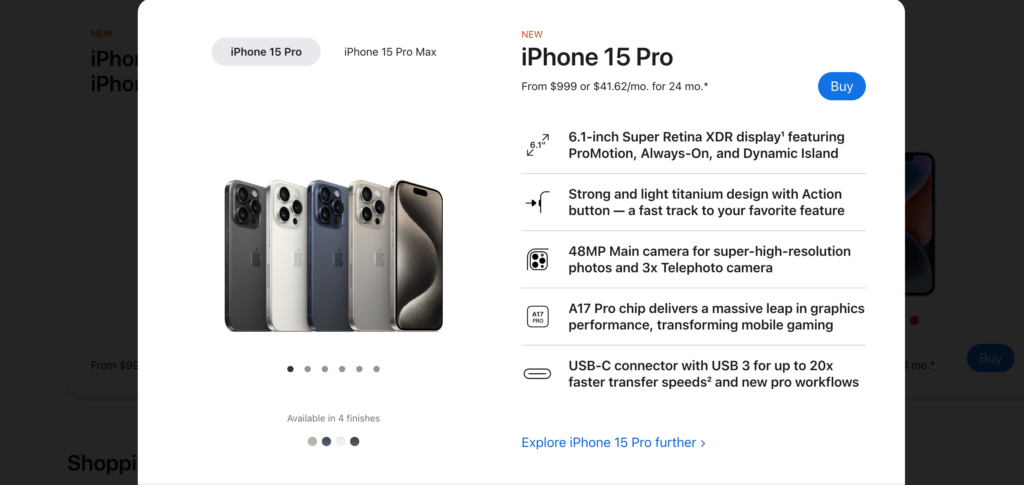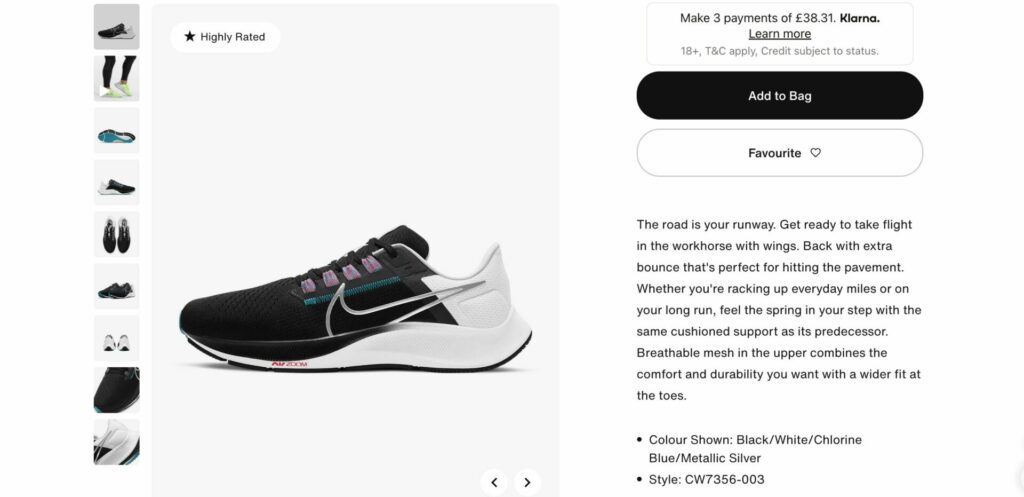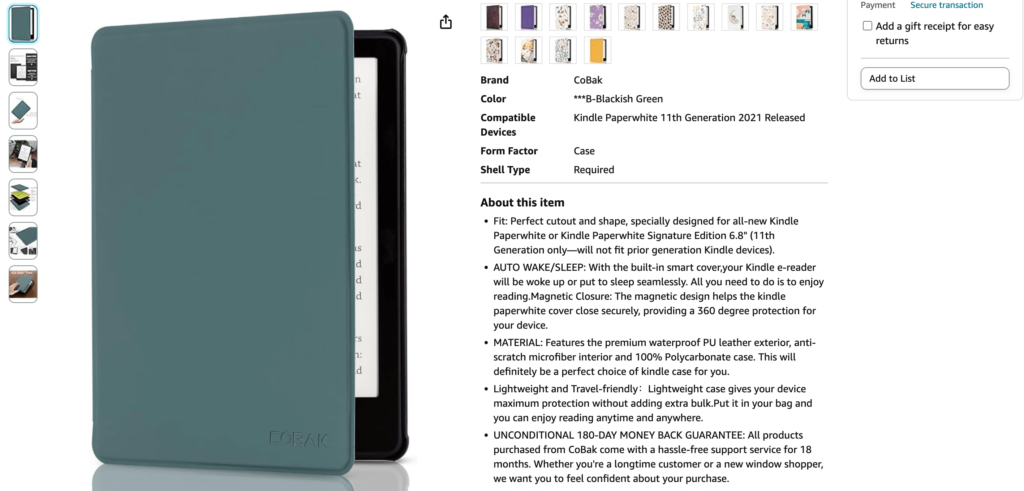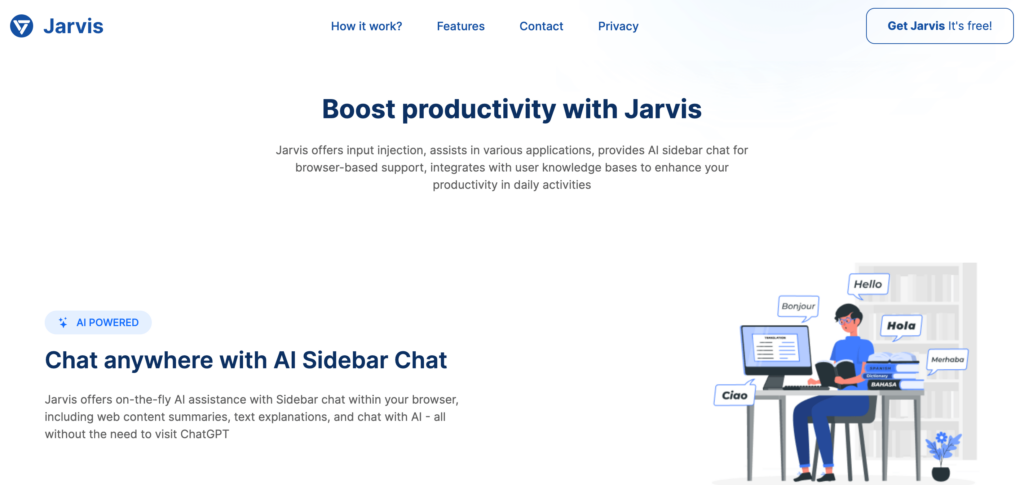A well-optimized product description works like a trained sales team, quietly convincing customers to buy your products. It also helps shoppers understand what you’re selling and why they should buy it.
Recent research by Shopify shows that-
30% of shoppers abandon carts due to poor product descriptions.
A good product description should go beyond only dry text and specs. So, forget those bland bullet points and generic jargon.
Instead, make your product description sweet, simple, and attractive to educate your customers and persuade them to buy.
Today, in this blog, we are going to discuss 9 proven points for writing descriptions like a pro. So, stay tuned to learn how to write eCommerce product descriptions that lead to more sales!
Why Product Descriptions Are Important for an eCommerce Site

When you are selling online products, product descriptions are your silent salespeople. Because your customers can’t physically touch or interact with your online products,
A well-written product description plays a crucial role in influencing buying decisions, building trust, and ultimately driving sales for your eCommerce store.
Let’s find a few more reasons for writing eCommerce product descriptions:
(I) More Sales
Compelling descriptions act as your conversion engine. They inform, educate, and persuade potential buyers by highlighting the product’s features, benefits, and value proposition.
A clear and concise description addresses customer concerns and eliminates purchase roadblocks, ultimately leading them toward that coveted “Add to Cart” click. Studies show that:
82% of shoppers consider product descriptions as extremely or very influential in their purchasing decisions.
(II) Better Customer Experience
Imagine walking into a store with mute salespeople pointing at products. Not ideal, right? Product descriptions bridge that gap in the online world. They provide essential information, answer questions, and guide customers through the buying journey.
Clear descriptions create a positive and informative experience, building trust and encouraging repeat business.
(III) Improve Search Engine Visibility
By strategically incorporating relevant keywords, you increase your product’s discoverability in search engine results. This means more targeted traffic and potential customers landing on your site, ready to explore your offerings.
(IV) Establish Trust and Credibility
Well-written product descriptions convey professionalism and attention to detail, instilling trust in your brand. Clear and accurate descriptions reassure customers about the quality and reliability of your products, ultimately building credibility and loyalty.
(V) Reduce Churn Rates
Clear and accurate product descriptions help set realistic expectations for customers regarding what they will receive. When shoppers have a thorough understanding of a product’s features, specifications, and use cases upfront, they are less likely to be disappointed upon receiving the item.
eCommerce Product Description Best Practices- What You Should Include and Exclude
You should follow eCommerce product descriptions when you are writing them for your online products.
Here are a few eCommerce product description best practices:
- Focus on benefits: Focus on how the product improves lives, solves problems, or fulfills desires.
- Clear and concise language: Avoid jargon, use short sentences, and explain technical terms.
- Sensory details and storytelling: Evoke emotions and paint a picture with vivid descriptions.
- Scannable structure: Use bullet points, headings, and white space for easy reading.
- SEO optimization: Incorporate relevant keywords naturally.
- All essential information: Dimensions, materials, care instructions, etc.
- Proofreading and polishing: Ensure error-free and grammatically correct descriptions.
Things You Should Exclude from Your eCommerce Product Descriptions
Here are a few important points that you should exclude from your eCommerce product descriptions:
- Exaggerated claims or misleading information: Build trust with transparency and accuracy.
- Generic, one-size-fits-all descriptions: Tailor to your target audience and their needs.
- Technical jargon unless explained: Assume no prior product knowledge.
- Overly promotional language: Let the benefits speak for themselves.
Don’t forget to follow these eCommerce product descriptions best practices when writing descriptions for your online products.
How to Write eCommerce Product Descriptions: 9 Secrets to Grow Your Online Sales

A well-written product description not only persuades customers to buy products but also encourages them to come back again.
87% of consumers are unlikely to make a repeat purchase if they do not see accurate product descriptions.
So, learn these 9 actionable tips to write your eCommerce product descriptions that convert visitors into customers:
- Research Your Audience
- Choose a Format
- Focus on Benefits, Not Features
- Use Powerful Words
- Make It Scannable
- Use Common Words
- Optimize for Search Engines
- Use Brand Tone
- Add Social Proof
After taking a quick look at the list, let’s now discuss each of the points in detail:
01. Research Your Audience
Understanding your audience is paramount when crafting effective eCommerce product descriptions. Before you start writing, take the time to research and analyze your target demographic.
Follow these steps to research your target audience:
- Personas: Craft detailed profiles of your ideal customers. Consider demographics, interests, pain points, and buying habits. What motivates them? What questions do they have?
- Analytics: Dig into your website analytics. Which demographics convert the most? Are there specific product pages that attract certain audiences? Look for patterns and commonalities.
- Surveys and Feedback: Ask your existing customers directly. Conduct surveys, host Q&A sessions, or analyze reviews to understand their needs, preferences, and language.
- Social Listening: Tune into their online conversations. What are they saying about similar products? What resonates with them? Track relevant hashtags and industry discussions.
- Competitor Research: Analyze how your competitors describe their products. What tone do they use? What benefits do they highlight? Learn from their successes and identify gaps you can fill.
By thoroughly researching your readers, you can tailor your product descriptions to resonate with their interests, preferences, and pain points. This targeted approach ensures that your descriptions effectively communicate the value proposition of your products and compel readers to take action.
02. Choose a Format
First impressions matter, especially online, and your product descriptions are often the first thing potential customers encounter. But with countless products wrestling for attention, standing out is crucial. That’s where choosing the right format comes in.
Let’s face it, some shoppers are browsers, not readers. For technical products or those with many features, bullet points are your best friend. Keep them short, sharp, and focused on specs and functionality.
But be warned, bullet points have limitations. They can’t tell a story, evoke emotions, or create a connection with the customer. This is where the power of prose shines.
Craft a paragraph or two that paints a picture. Transport your reader into a world where your product transforms their life. Is it a cozy robe that promises ultimate relaxation? Or a high-tech gadget that unlocks boundless possibilities? Help them feel the need, not just see the features.
So, which format is the best? Bullet points or paragraphs? Instead of choosing one way, why don’t you combine them?
A perfect eCommerce product description = Short description + Bullet points
Start with a captivating paragraph that sets the scene, then follow it with a bullet list that reinforces key features and specifications. This creates a balanced and informative description that satisfies both quick scanners and story seekers.
03. Focus on Benefits, Not Features
When you write about the stuff you’re selling online, focus on telling people how it helps them instead of just what it can do. Explain how it meets their needs, makes them feel good, stands out from other things, and fixes any worries they might have.
Here is how you can do that:
- Identify Customer Pain Points: What problems does your product solve? What frustrations does it alleviate?
- Highlight the Emotional Impact: How will your product improve their lives? Make them feel confident, beautiful, organized, etc.
- Use Sensory Language: Evoke emotions through descriptive words that paint a picture.
- Focus on Transformation: Show how your product takes them from their current state to a desired one.
- Keep It Concise and Clear: Avoid technical jargon and complex sentences.
Now let us give you a couple of examples that will help you understand this step more clearly!
Feature: “Made with 100% organic cotton.”
Benefit: “Soft, breathable fabric for ultimate comfort on sensitive skin.”
Here is another example for you:
Feature: “5-blade technology with self-sharpening blades.”
Benefit: “Effortless, close shave that minimizes irritation and lasts longer.”
So, which one sounds more perfect to you? Obviously. It’s the benefit part, right?
Benefits aren’t just marketing fluff; they’re the heart of your message. This is why you must follow the rule: Focus on benefits, not features.
04. Use Power Words
Using certain words can grab people’s attention and convince them to buy things. These are called “power words.” They’re words that make you feel something, like excitement or wanting.
When you use these words in your product descriptions, they can make people more interested and more likely to buy what you’re selling. So, by adding these words here and there, you can get people to pay attention and want to buy your stuff.
Here’s how they work:
- Spark Emotions: Words like “luxurious,” “revolutionary,” or “irresistible” tap into deep-seated desires and create a sense of excitement.
- Paint a Picture: Use sensory words like “silky,” “vibrant,” or “aromatic” to transport readers into a world where they can experience your product firsthand.
- Boost Confidence: Words like “proven,” “reliable,” or “guaranteed” build trust and assure customers they’re making the right choice.
- Create Urgency: “Limited edition,” “exclusive,” or “disappearing fast” trigger a fear of missing out, motivating immediate action.
But remember, power words are like spices, use them sparingly and strategically. Too many can overpower your message and sound gimmicky.
05. Make It Scannable
Everyone is busy and in terms of online shopping, customers skim pages, not read novels. That’s why making your product descriptions scannable is crucial.
So, how do you transform your descriptions into scannable masterpieces? Here are a few simple yet impactful tips for you:
- Embrace White Space: Don’t crowd your text. Break it up with generous space for visual breathing room.
- Headline Heroes: Start with clear, concise headlines that capture the essence of the product.
- Bullet Point Brilliance: Use bullet points to showcase key features and benefits in easily digestible chunks.
- Bold and Beautiful: Strategically highlight important information with bolding or italics.
- Subheadings: Guide the reader’s eye with clear subheadings that break down information.
- Image is Key: High-quality product images instantly tell a story and complement your text.
Scannable descriptions allow shoppers to quickly find the information they’re looking for, making it more likely that they’ll stay on your page and consider making a purchase. So, when writing product descriptions, remember to keep them scannable to cater to the browsing habits of online shoppers.
06. Use Common Words, Short Sentences, and Concise Paragraphs
First, let’s check out an example:
This versatile backpack boasts multiple compartments, adjustable straps, and water-resistant fabric, making it ideal for hiking, or everyday adventures. The breathable mesh back panel ensures comfort even on the hottest days, while the internal organizer keeps your belongings neatly sorted. Whether you’re conquering a mountain trail or navigating the city streets, this backpack is your perfect companion.
Be honest! Did you really read the above paragraph? No, right? You just skimmed.
However, if you rewrite it like the following:
Conquer trails or city streets with this versatile backpack!
- Multiple compartments & adjustable straps for organized & comfy carrying.
- Water-resistant fabric keeps your gear dry in any weather.
- Breathable mesh back panel for cool comfort on hot days.
Now it has become easy and interesting to read, right?
Follow these tips to make your sentence sweet and simple:
- Ditch the Jargon: Avoid technical terms and industry slang most people don’t understand. Aim for words anyone can grasp.
- Embrace Contractions: Don’t be afraid to use “isn’t” instead of “is not.” It sounds more natural and relatable.
- Keep Sentences Short and Sweet: Aim for an average sentence length of 15-20 words. Readers will appreciate the easy flow.
- Paragraphs with Purpose: Limit paragraphs to 3–4 sentences, focusing on a single key point in each.
- Read Aloud: Test your descriptions by reading them aloud. Does it sound natural and easy to understand? If not, then consider rewriting it.
By using common words, short sentences, and concise paragraphs, you ensure that your product descriptions are accessible to a wide audience and can be easily understood by everyone.
07. Optimize for Seach Engines
You have amazing products, but if nobody can find them online, what’s the point of having the most amazing products? Visibility is key. In terms of selling your products to your customers, you need to make visible your products to your target audience.
To get this job done, you have to optimize your product description for search engines. Check out these tips for optimizing product descriptions like a pro!
- Keyword Research: Identify relevant keywords and phrases your target audience uses to search for similar products. Tools like Google Keyword Planner can help.
- Strategic Placement: Naturally incorporate these keywords throughout your descriptions, including titles, headers, and product copy.
- Don’t Keyword Stuff: Overusing keywords can hurt your ranking and sound unnatural. Maintain a balance and prioritize readability.
- Mobile-Friendliness is Key: Ensure your descriptions are optimized for mobile devices, where most searches happen today.
- Internal Linking: Link your product descriptions to relevant categories and landing pages for improved site structure and SEO.
Remember, SEO is an ongoing process. Track your progress, analyze results, and adapt your strategies based on what resonates with your audience and search engines.
08. Use Brand Tone
Your brand tone is the personality and style of communication that reflect your brand’s identity. When writing eCommerce product descriptions, it’s important to use a consistent brand tone that resonates with your target audience and reinforces your brand image.
Here is how you can use brand tone while writing descriptions for your eCommerce products:
- Define Your Brand Voice: Consider your brand personality, values, and target audience. Are you playful and fun? Sophisticated and expert? Define these qualities clearly.
- Use Consistent Language: Maintain your chosen voice across all descriptions, avoiding inconsistency.
- Show, Don’t Tell: Don’t just claim your brand is fun; use playful language and vivid descriptions to convey it.
- Highlight Brand Values: Infuse your descriptions with values like sustainability, innovation, or community spirit.
- Avoid Industry Jargon: Speak your audience’s language, not industry insider terms.
A brand’s tone is not just about words, it’s about emotions. So, properly use it throughout your eCommerce product descriptions.
09. Add Social Proof
Social proof means that when people see others doing something or saying something, they’re more likely to do or believe the same thing. Using social proof in your product descriptions on your online store can make people trust your products more.
Here’s how you can do it:
- Showcase Customer Reviews and Testimonials: Feature positive quotes, star ratings, or even video testimonials showcasing real customer experiences.
- Highlight Social Media Mentions: Share user-generated content like photos or tweets expressing satisfaction with your product.
- Display Influencer Endorsements: If relevant, showcase positive reviews or recommendations from industry experts or trusted figures.
- Utilize Case Studies: Share detailed stories of how your product helped specific customers overcome challenges or achieve goals.
- Feature Awards and Recognition: Include logos or mentions of awards or accolades your product has received.
Social proof serves as validation of your brand’s reputation and quality. So, if you can showcase it properly with your product descriptions, it’ll help you get higher conversion rates and customer satisfaction.
5 Top eCommerce Product Description Examples That You Should Check for Inspiration
1. Apple: iPhone 12 Pro

- Why It’s Effective: Apple’s product descriptions are known for their simplicity, clarity, and focus on key features and benefits. The description emphasizes the iPhone 15 Pro’s advanced camera system, super retina XDR display, and faster transfer speed, highlighting its transformative capabilities.
2. Nike: Air Zoom Pegasus 38 Running Shoes

- Why It’s Effective: Nike’s product descriptions are known for their emphasis on performance and technology. The description of the Air Zoom Pegasus 38 highlights its responsive foam cushioning, breathable mesh upper, and comfortable fit, appealing to runners looking for high-quality athletic footwear.
3. Sephora: Urban Decay Naked3 Eyeshadow Palette

- Why It’s Effective: Sephora’s product descriptions excel at evoking emotion and highlighting the unique features of beauty products. The description of the Naked3 Eyeshadow Palette emphasizes the range of shades, finishes, and convenience of the palette, appealing to makeup enthusiasts seeking versatility and portability.
4. Casper Sleep – The Original Foam Mattress

- Why It’s Effective: Casper Sleep’s product descriptions are known for their focus on sustainability, quality, and humor. With the “Don’t Lose Sleep” copy they reflect their humor and the “100-night risk-free trial” copy shows their sustainability and quality.
5. Amazon: Kindle Paperwhite E-Reader

- Why It’s Effective: Amazon’s product descriptions are known for their comprehensive coverage of features and benefits. The description of the Kindle Paperwhite highlights its high-resolution display, adjustable light, long battery life, and extensive content library, appealing to book lovers looking for a convenient and immersive reading experience.
These eCommerce product description examples showcase effective techniques for capturing attention, conveying product benefits, and inspiring purchase decisions. So, you can take some inspiration from these examples while writing descriptions for your eCommerce products.
Bonus: 3 Best eCommerce Product Descriptions Generator
If you want to use product descriptions for your eCommerce products, you can choose from the top eCommerce product description generators. It will help you write top-quality descriptions by saving you time on a large scale.
In this segment, we are going to discuss the top 3 eCommerce product description generators for you.
01. Copy.ai
Copy.ai is a versatile AI-powered copywriting tool that offers a range of features, including product description generation. It utilizes advanced natural language processing (NLP) algorithms to generate high-quality descriptions tailored to specific products.

Key Features
- Customizable Templates: Copy.ai provides various templates for different types of product descriptions, allowing users to choose the most suitable one for their needs.
- AI-driven Description Generation: The tool analyzes product attributes and generates descriptions based on input parameters such as product category, features, and target audience.
- SEO Optimization: Copy.ai assists in optimizing descriptions for search engines by suggesting relevant keywords and phrases to include.
- Integration Options: It seamlessly integrates with popular eCommerce platforms and content management systems, streamlining the process of generating and publishing product descriptions.
02. Jarvis (Formerly Conversion.ai)
Jarvis is another AI-powered copywriting assistant that excels at generating persuasive and engaging product descriptions. It employs machine learning algorithms to analyze data and produce compelling content tailored to specific product attributes.

Key Features
- Versatile Content Generation: Jarvis can generate various types of content, including product descriptions, blog posts, ad copy, and more.
- Dynamic Templates: Users can choose from a range of templates optimized for eCommerce product descriptions, enabling quick and easy content creation.
- Language Customization: Jarvis allows users to define the tone, style, and voice of the generated descriptions, ensuring consistency with brand messaging.
- Collaboration Features: The tool offers collaboration features that allow multiple team members to contribute to and review the generated content.
03. Writesonic
Writesonic is a content generation platform that includes a product description generator among its suite of tools. It leverages AI technology to produce high-quality descriptions that capture the essence of each product.

Key Features
- Smart Content Generation: Writesonic’s AI algorithms analyze product data and generate descriptions that resonate with target audiences, emphasizing key features and benefits.
- Multichannel Support: The platform supports multiple content formats and channels, allowing users to generate descriptions for eCommerce websites, social media, email campaigns, and more.
- Customization Options: Writesonic offers customization options for tone, style, and length, enabling users to tailor descriptions to their brand and audience preferences.
- Integration Capabilities: The tool integrates with popular eCommerce platforms and content management systems, facilitating seamless content creation and publishing workflows.
If you want to use an eCommerce product description generator tool, you can pick any of the above-mentioned tools based on your requirements.
Write a Well-optimized eCommerce Product Description That Generates More Sales
Congratulations! You’ve explored the 9 key strategies for writing product descriptions and witnessed a few perfect real-world product description examples.
Now, you have all the information and ideas you need to turn your product descriptions from boring lists into exciting stories that grab people’s attention and make them want to buy.
Crafting compelling eCommerce product descriptions is a journey, not a destination. So, don’t be afraid to experiment, test different approaches, and track your results to see what resonates with your audience.
Now, if you have any further queries on how to write eCommerce product descriptions that generate more sales, feel free to share them with us using the comment box below. We would love to know your feedback. Take care!
Subscribe to
Dokan blog
We send weekly newsletters, no spam for sure!




